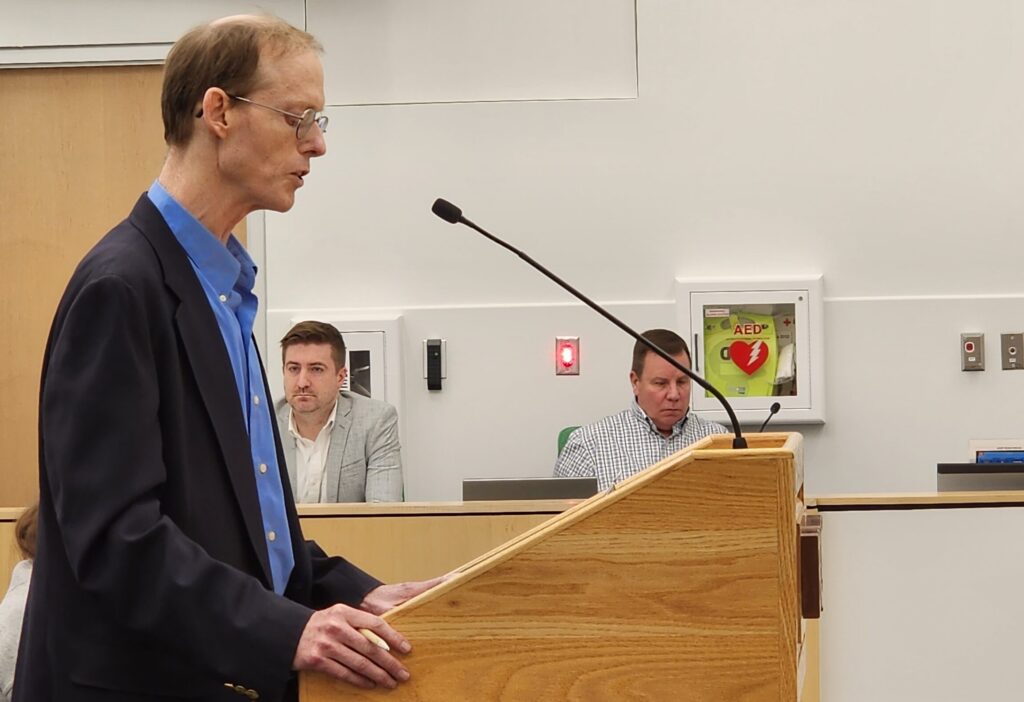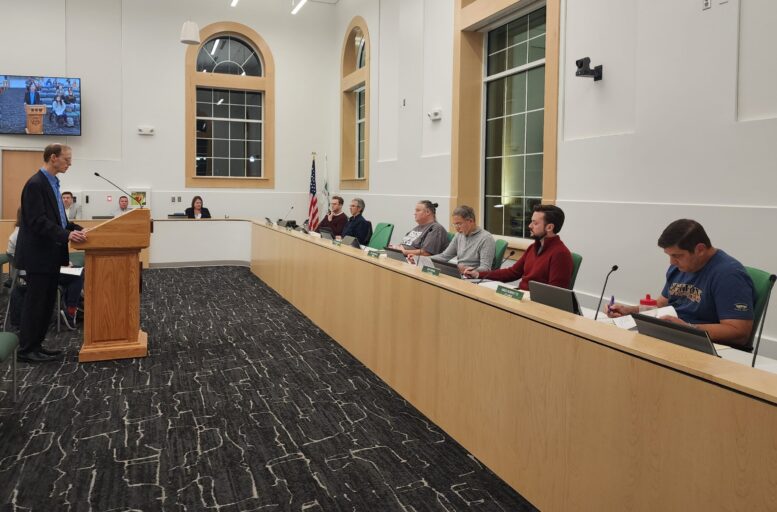By JAN LARSON McLAUGHLIN
BG Independent News
Over the last five years, as wildfires raged, floods washed out communities and heat waves baked areas across the globe, Bowling Green leaders and climate change experts have worked away at legislation to protect the world.
The fruition of those efforts was presented Monday evening at Bowling Green City Council in the form of a resolution introduced by council member Bill Herald.
But another council member was quick to point out that not everyone on council supports the sustainability resolution. Normally, discussion on proposed legislation is reserved for the second or third reading before council. But on Monday, Greg Robinette wanted to make his feelings clear from the very beginning.
“There is not unanimity on this,” Robinette said of the carbon dividend resolution.
He called the legislation “unnecessarily verbose” and balked at the idea that it is supported by all on City Council. “That is absurd and is not true.”
The legislation calls for national leaders to consider a fee on carbon emissions, with the fees being turned into dividends for U.S. citizens, as part of a nationwide solution to detrimental climate changes.
Herald said the proposal allows local communities to voice their concerns to state and national leaders. It is an effort to find comprehensive solutions through bipartisan support, he said.
Bob Clark-Phelps of Perrysburg, who is part of the Citizens Climate Lobby, stressed how important it is for communities to weigh in on this issue to let state and national leaders know it matters at the grassroots level.
“What’s at stake is the stability of our ecosystem,” Clark-Phelps said.
“You are the voice of residents of Bowling Green,” he said. “Please safeguard the quality of life for residents of Bowling Green.”

Charlotte Reith, of Bowling Green, echoed those concerns. She pointed out the costs to communities if local governments don’t take a stand on the issue. If extreme weather continues to go unchecked, communities will have to spend far more to deal with the effects on infrastructure, Reith said.
“Congress needs to hear these are concerns at the local level,” she said.
Craig Zirbel also voiced his support for the carbon fee dividend. He explained his initial irritation at being charged a fee by the state for his electric car. But then he realized that his car was putting wear and tear on the roads, and was not paying for that through traditional gas taxes.
This proposal would work the same way, with people who burn more fossil fuels being required to pay more.
Robinette said that while he supports pollution reduction efforts, the proposed resolution goes too far. It would push for the elimination of carbon intensive products like iron, steel, aluminum, glass, pulp, paper and industrial ceramics – plus impact jobs in crude oil refineries, coal mining and natural gas production.
Robinette asked how communities would recover when those businesses are shuttered. He added that he can’t endorse the resolution – now or ever.
The resolution states that Bowling Green acknowledges that the solution to environmental issues must be multifaceted, involving innovation in scientific, technological, engineering, economic and governmental areas.
As part of the solution, the resolution expresses support for a well-balanced, practical and pragmatic, bi-partisan federal Carbon Fee and Dividend policy as a means to reduce the environmental and human costs of the emissions generated by burning fossil fuels. That policy may result in a fee placed on emissions and a carbon dividend, through which all revenues from the fee (minus fixed administration costs) could be distributed equally to all U.S. citizens on a monthly basis to offset any potential increase in the cost of goods and services resulting from the fee.
According to the resolutions, one of the weaknesses of the market system is the “tragedy of the commons” – a situation in which individuals with access to a public resource act in their own interest and ultimately deplete the resource.
Those who pay for a product (like electricity, cement and steel) generally do not directly pay for the harm due to byproducts of the production process, so they do not accurately reflect the proper total cost of production and pass that portion of the costs to others.
The resolution states that a market-based solution, generally known as a Carbon Fee and Dividend policy, could provide a partial yet significant solution – if fashioned correctly in a bi-partisan manner with the strengths and weaknesses honestly identified and properly balanced.
According to the resolution, more than 3,500 U.S. economists, 28 Nobel Laureates in Economics and four previous chairs of the Federal Reserve have signed an open letter supporting the use of a steadily rising fee on carbon emissions with revenue returned to U.S. citizens, and a border carbon adjustment system as the “most cost-effective lever to reduce carbon emissions at the scale and speed that is necessary.”
The resolution also states that the U.S. Chamber of Commerce supports a “market-based approach to accelerate greenhouse gas emissions reductions across the U.S. economy,” and the American Petroleum Institute, the Electric Power Supply Association, and the Business Roundtable all support putting a price on carbon emissions.
A carbon fee and dividend policy would return all revenues as they increase (minus fixed administration costs) to U.S. households as a monthly dividend, to offset expected higher prices for goods and services.
Such a policy would protect lower and middle-income households, as the dividend would allow an estimated 85% of U.S. households to benefit financially, break even or have only minimal increased costs.
According to the resolution, the revenue-neutral emission fee and dividend policy is an effective method to reduce carbon emissions for the following reasons:
- The fee would motivate businesses and consumers alike to conserve energy and reduce carbon emissions without the need for governmental regulatory controls or infrastructure.
- The fee would incentivize the elimination of waste and inefficiency.
- The fee would be refunded in the case that emissions from burning fossil fuels are captured and sequestered.
- The fee would act as a flexible, market-based approach to encourage innovation, thereby reducing carbon emissions, not only in energy production, but also in every field in which emergency is consumed, such as electric vehicles, architectural planning and construction, water heating, lighting and air conditioning.
- The fee is levied at the point of production, which is more efficient, less expensive and provides more accurate signals to the marketplace than a fee levied at the point of consumption.
- The fee would eliminate the need for government subsidies of alternative energy sources.
- The fee is fairer to all businesses and consumers because it will more accurately reflect production costs.
- A carbon border adjustment mechanism would assess a fee on goods traded with countries without a comparable emission fee, thereby maintaining the competitiveness of U.S. businesses, ensuring that no competitive advantage would be created under this policy from relocating operations to other countries, and also incentivizing other countries to establish a matching price on carbon emissions.
Bowling Green has already demonstrated leadership in adoption of low-carbon sources of energy, as acknowledged by being designated as one of the 60 “Smart Energy Providers” nationwide.
The city has also shown this to be a priority by creating a Sustainability Committee on City Council.
In 2021, City Council approved a resolution calling on the city to create a sustainability and climate plan where “the city will endeavor to reach net zero greenhouse gas emissions from electricity production and city operations…” where “net zero emissions will be achieved when greenhouse gas emissions released by electricity production and city operations are counterbalanced by removing an equivalent amount of greenhouse gas emissions from the atmosphere.”

